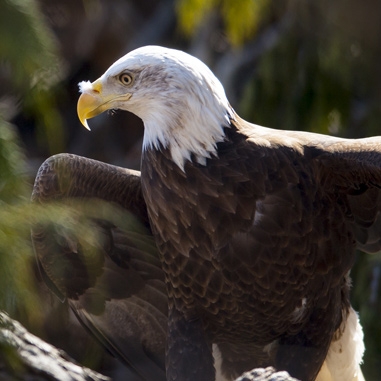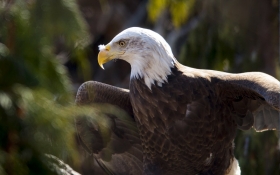
Bald Eagle
Haliaeetus leucocephalus
Animal Behavior: The Bald Eagle, (Haliaeetus leucocephalus) is one of the largest raptors in North America. This bird of prey, has a 5-7 ft wingspan and can live up to 30 years. They can fly 30-45 miles per hour when soaring and fly up to 100 miles per hour when diving after prey. Eagles have an acute eyesight with visual acuity 6 times better than humans. They are capable of seeing a mile away. Although adult eagles look identical, the female eagle is larger than the male. Eagle pairs bond for life and build the largest nest of any North American bird. A Bald Eagle&rsquos nest can weigh up to 2,000 pounds. Eagle pairs return to the same nest each year. A female Bald Eagle lays 1-3 eggs, each with a separation between each egg laid. Eggs hatch in the order in which they are laid. Baby eagles are called Eaglets. The 1st born is the largest and gets fed the majority of the food - this is why, only one Eaglet will survive. Young Eagle fledglings leave the nest at 10-12 weeks, but still remain close to their parents to learn flying and feeding skills. It takes 5 years for a young eagle to mature and it&rsquos head to turn completely white.
Eating Habits: Eagles are scavengers but also feed on live fish, birds, and small mammals. They can take down prey larger than themselves.
Conservation Efforts: Bald Eagles are protected through the Endangered Species Act of 1966. The number of birds has shot up in recent years and the species is no longer endangered due to this Act.
Animal Facts: In addition to being the National bird of the United States, the Bald Eagle is seen as sacred in many Native American Cultures.
